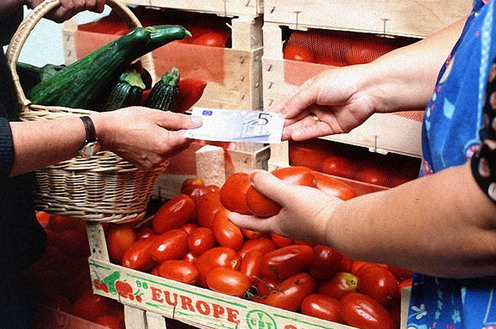Underlying inflation remains stable
Year-on-year rate of inflation rises by 0.1 points in October to -0.1%
News - 2014.11.13
When compared with the previous month, the general CPI rose by 0.5%, 0.1 points more than in October 2013.
The year-on-year rate of change posted by the price of non-prepared foodstuffs showed a significant increase from -1.5% in September to 1.7% in October. To a great extent, this trend stems from performance under the heading of fresh fruit, the prices of which rose by 2.8% year-on-year following a decrease of 5.4% in the previous month. This upturn is mainly due to a base effect stemming from the sharp drop seen in October 2013.
The cost of energy products posted a negative year-on-year rate in October of -1.1%, following a certain stabilisation in the previous month. The main components under this heading - solid and liquid fuels and the electricity tariff - contributed to this decrease. Solid and liquid fuels exacerbated the year-on-year rate of decline by 0.4 points to 3.3%, in line with oil price trends. The year-on-year rate posted by the electricity tariff fell from an increase of 8.4% in September to an increase of 4.9% in October as a result of a 0.7% monthly decrease in October this year, compared with an increase of 2.7% in the same month of 2013.
Underlying inflation (which excludes the most volatile components of the CPI, such as fresh foodstuffs and energy) remained unchanged in October at -0.1%. This stability can be explained by the performance of its three main components, which maintained their respective year-on-year rates: services at 0.1%, non-energy industrial goods at -0.3% and prepared foodstuffs at -0.2%.
Under the heading of services, prices in tourism and the hotel and catering industry rose by 0.1 points to 0.6%. To a great extent, this was due to organised travel. On the other hand, the year-on-year rate for inter-urban public transport fell by over 2 points to 0.9% and the year-on-year rate for university education slowed by 1.9 points to 1.4%. The cost of non-energy industrial goods maintained its year-on-year rate at -0.3%, with an increase of almost 1 point under motor vehicles to 2% and a lower increase of 0.2 points under clothing and footwear to 0.3%. Prepared foodstuffs, including beverages and tobacco, maintained a year-on-year rate of -0.2%. This stability can be explained by the increase under such headings as oils that offset the decreases under milk and dairy produce, coffee, cocoa and infusions and mineral water, soft drinks and fruit juices.
In month-on-month terms, the CPI rose by 0.5% in October, 0.1 points more than in the same month last year. This price increase can be explained by the increased cost of non-energy industrial goods and foodstuffs - both prepared and non-prepared - which was partially offset by the decrease in the cost of services and energy products. The price of non-prepared foodstuffs rose by 1.2%, due principally to the increased cost of fresh fruit and fresh legumes and vegetables. Prepared foodstuffs rose by 0.2%, due to the increased cost of oils and fats.
Energy products posted a monthly decrease of 1.9%, as a result of a decrease in solid and liquid fuels (-2.3%) and the electricity tariff (-0.7%). The cost of non-energy industrial goods rose by 3%, due to the seasonal increase in clothing and footwear (11%) and the slight increase in the price of motor vehicles (0.3%).
Falling service prices
Service prices fell by 0.4% in October on the previous month, mainly due to tourism and the hotel and catering industry (-0.8%). Under this heading, it is worth noting the falling cost of organised travel (-3.9%) and hotels, cafés and restaurants (-0.4%), as well as inter-urban public transport (-2.5%) and telephony services (-1.5%).
Six of the 17 autonomous regions posted a higher year-on-year rate of inflation than the national average in October: the Balearic Islands, La Rioja and the Basque Country (0.2%), Catalonia (0.1%), Galicia and the Region of Madrid (flat rate). Castile-Leon and Navarre matched the national average (-0.1%), while the remaining autonomous regions posted rates of inflation below the national average: Andalusia, Asturias and the Region of Valencia (-0.2%), Aragon, Cantabria, Castile-La Mancha, Extremadura and the Region of Murcia (-0.3%). The lowest rate of inflation in October was posted by the Canary Islands (-0.6%).
The year-on-year CPI rate at constant taxes stood at -0.1% in October, the same as the general CPI rate, 0.1 points higher than the previous month. The INE also published the harmonised CPI (HCPI) for October, the year-on-year rate of which stands at -0.2% (0.1 points higher than in the previous month). When comparing this rate with that estimated by Eurostat for the Eurozone as a whole (0.4%), the inflation differential remains positive for Spain at 0.6 percentage points.
In summary, the rate of inflation rose in October due to price trends in non-prepared foodstuffs, while underlying inflation remained unchanged at -0.1%. The inflation differential remains positive for Spain when compared with the Eurozone, which is enabling gains in competitiveness and boosting Spanish exports, with the corresponding positive impact on the recovery of economic activity and job creation.





